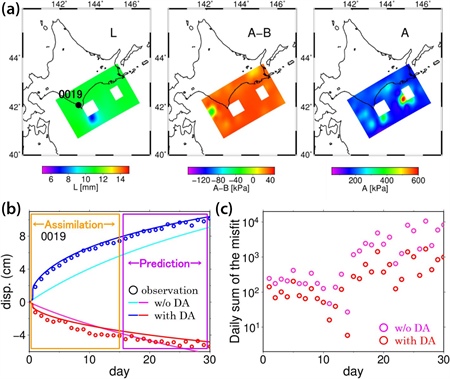By Masayuki Kano, Shin’ichi Miyazaki, Yoichi Ishikawa, and Kazuro Hirahara
Earthquakes are stress release processes that occur in subduction zones—areas where one tectonic plate sinks below another—and radiate seismic waves within a time span of only a few tens of seconds. In addition to this quick rupture process, a wide variety of fault slips with different time constants transpire during earthquake cycles. For example, researchers around the world have detected slow earthquakes that are characterized by longer durations than ordinary earthquakes [5].
Scientists typically classify slow earthquakes into multiple categories—such as slow slip events, low-frequency earthquakes, very low-frequency earthquakes, and tremors—based on their characteristic time scales. Another type of slow fault slip is an afterslip, which follows a large earthquake due to the stress perturbations from coseismic stress release. While these slow fault slips themselves do not result in devastating seismic damage, they can load tectonic stress into seismogenic zones. In fact, slow slips often occur before large earthquakes [4]. Investigations of the spatiotemporal behavior of slow fault slips can hence improve our understanding of earthquake cycles.
Figure 1. Flow of data assimilation (DA) for the prediction of fault slip behavior in subduction zones. Figure courtesy of the author.
In pursuit of our ultimate goal to accurately predict seismic fault slips and earthquakes, we are developing a data assimilation (DA) system that monitors slow fault slips [1-3]. DA combines observations with physics-based simulations and has been widely adopted in the fields of meteorology and oceanology — especially for practical uses like weather forecasting. The governing equations for fault slip modeling include friction law and the equation of motion in an elastic media. Since the wide variety of fault slip behaviors is thought to reflect frictional properties along the subducting plate interface, we assign the spatial heterogeneity of frictional properties in friction law to reproduce various slip behaviors in our model. The purpose of DA is to therefore optimize frictional properties based on crustal deformation from global navigation satellite system (GNSS) observations, then predict the short-time spatiotemporal evolution of fault slips. We adopted an adjoint DA method, i.e., a four-dimensional variational method; Figure 1 summarizes the flow of DA in our problem.

Figure 2. Results of data assimilation (DA) for afterslip monitoring. 2a. Spatial distributions of frictional properties. 2b. Temporal evolution of surface displacement at the global navigation satellite system (GNSS) station in Erimo, Japan, which is represented by the black circle in Figure 2a. The red and pink lines are the calculated crustal deformation in the trench-parallel direction with and without DA, respectively; the red circles indicate the corresponding observed values. Similarly, the dark blue and light blue lines are the calculated crustal deformation in the trench-perpendicular direction with and without DA; the blue circles indicate the corresponding observed values. We assimilated the observed data in the first 15 days and only used data from the subsequent 15 days for comparison with the calculated values. 2c. Temporal change of the residuals that we obtained by summing the misfits for all GNSS stations. Red and pink circles respectively indicate the results with and without DA. Figure adapted from [2].
Our 2020 study [2] focused on the afterslip that followed the 2003 Tokachi-Oki earthquake: an 8.0 magnitude event that impacted northeast Japan. This was the first earthquake to take place after the establishment of the
dense GNSS observation network in Japan, and the station that was closest to the epicenter observed more than eight centimeters of postseismic deformation within two weeks. We assimilated GNSS data for 15 days (the assimilation period) after the mainshock to optimize frictional properties of the afterslip area, then examined the short-term predictability of GNSS data for the subsequent 15 days (the prediction period). Figure 2a depicts our optimization of the spatial distributions of frictional properties — specifically the three frictional parameters A, A-B, and L in friction law, which often describe friction in solid Earth science. Figure 2b summarizes our comparisons of observed and calculated crustal deformation, demonstrating that the observations were reproduced in the assimilation period
and predicted in the prediction period after DA. We can quantitatively evaluate this outcome via the temporal change of the misfit between the observed and calculated crustal deformation (see Figure 2c).
We are currently developing a monitoring system for slow slip behavior with a particular focus on the Nankai subduction zone in southwest Japan, where large megathrust events have historically occurred with intervals of 100 to 150 years. The integration of DA and geodetic data analysis—which is innovated with powerful information science technologies like machine learning—is accelerating our DA-based monitoring of fault slip in plate subduction zones. If you are interested in this effort, please refer to our associated papers [1-3] and project website. We are happy to partake in innovative collaboration for future earthquake prediction.
Masayuki Kano delivered a minisymposium presentation on this research at the 2022 SIAM Conference on Mathematics of Data Science, which took place in San Diego, Ca., last September.
References
[1] Hirahara, K., & Nishikiori, K. (2019). Estimation of frictional properties and slip evolution on a long-term slow slip event fault with the ensemble Kalman filter: Numerical experiments. Geophys. J. Int., 219(3), 2074-2096.
[2] Kano, M., Miyazaki, S., Ishikawa, Y., & Hirahara, K. (2020). Adjoint-based direct data assimilation of GNSS time series for optimizing frictional parameters and predicting postseismic deformation following the 2003 Tokachi-oki earthquake. Earth Planets Space, 72, 159.
[3] Kano, M., Miyazaki, S., Ishikawa, Y., Hiyoshi, Y., Ito, K., & Hirahara, K. (2015). Real data assimilation for optimization of frictional parameters and prediction of afterslip in the 2003 Tokachi-oki earthquake inferred from slip velocity by an adjoint method. Geophys. J. Int., 203(1), 646-663.
[4] Kato, A., Obara, K., Igarashi, T., Tsuruoka, H., Nakagawa, S., & Hirata, N. (2012). Propagation of slow slip leading up to the 2011 Mw 9.0 Tohoku-Oki earthquake. Science, 335(6069), 705-708.
[5] Obara, K., & Kato, A. (2016). Connecting slow earthquakes to huge earthquakes. Science, 353(6296), 253-257.
 |
Masayuki Kano is an assistant professor at Tohoku University. He is a seismologist who is currently leading a project to develop a data assimilation system for fault slip monitoring by integrating information science and seismology. |
 |
Shin’ichi Miyazaki is a professor who leads the Geodesy Laboratory at Kyoto University. He specializes in geodetic data analysis. |
 |
Yoichi Ishikawa is director of the Research Institute for Value-Added-Information Generation’s Center for Earth Information Science and Technology at the Japan Agency for Marine-Earth Science and Technology. He specializes in ocean data assimilation. |
 |
Kazuro Hirahara is an emeritus professor at Kyoto University and a part-time staff member at the RIKEN Center for Advanced Intelligence Project. He specializes in seismology and is currently working to integrate seismology and information science. |